26 F. average high on February 3.
24 F. high temperature on February 3, 2016.
February 4, 1984: The event termed the 'Surprise Blizzard' moves across Minnesota and parts of the Dakotas. Meteorologists were caught off guard with its rapid movement. People described it as a 'wall of white.' Thousands of motorists were stranded in subzero weather. Only a few inches of snow fell, but was whipped by winds up to 80 mph. 16 people died in stranded cars and outside.
Potential For Another "Fast-Foward Spring" Grows
Don't get me wrong, I'm a fan of spring. I like it best when it comes...in the spring.
Lately most Minnesota winters have been sickly; snow sharing the spotlight with ice and rain. Piles of dirty snow and frustrated winter weather enthusiasts. There are exceptions: 3 winters ago brought back memories of the 70s and early 80s. But there's little doubt that winters are trending shorter and milder over time.
As much as I don't miss consecutive weeks below zero I'm sad to see our winters under stress.
Remember when it snowed in late October and (predictable) snow would linger into April? Right.
According to The National Weather Service the first week of February is when we should have the most snow on the ground. Instead of 6-7 inches, the MSP metro has a trace. Models print out a chance of a few inches Tuesday, followed by a couple of cold days, then rapid warming late next week.
A relatively mild, Pacific wind flow overwhelms the pattern across the USA for much of February. GFS guidance hints at 50 F. here two weeks from today.
No, it's not your grandfather's winter anymore.
February temperature outlook above courtesy of NOAA CPC (Climate Prediction Center).
Cold Getting Less Cold. Climate Central takes a look at the larger trends: "For many locations in the U.S., middle-to-late January is climatologically the coldest time of the year. But extreme cold is on the decline as the world warms from increasing greenhouse gases from the burning of fossil fuels. This week’s analysis examines the coldest night each year in these cities. Even though we will continue to see cold outbreaks in a warming world, the trend in the vast majority of the cities analyzed shows that these extreme cold nights are happening less often. Conversely, as cold extremes continue to become fewer and less intense, hot extremes become stronger and more frequent..."
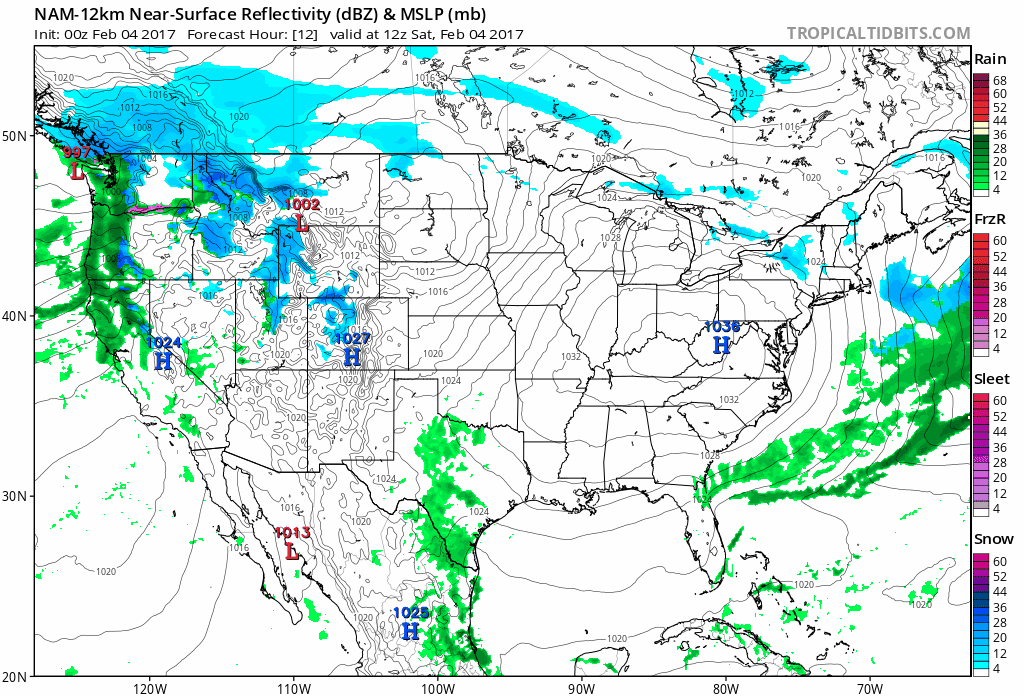
84-Hour Weather Map. Light snow spreads across the Upper Mississippi Valley into the Great Lakes and New England into Sunday; while more sloppy fronts push heavy rain, ice and snow into the west coast with light showers from Texas into the Deep South. Animation: NOAA and Tropicaltidbits.com.
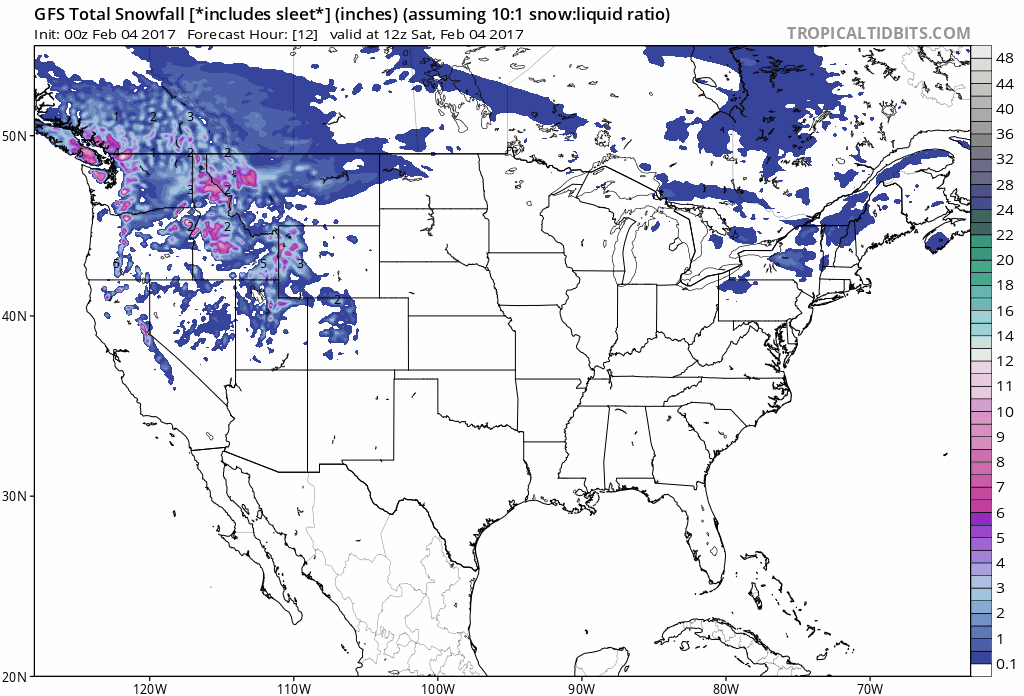
Snowfall Potential Next 6 Days. GFS total snowfall predictions through next Friday evening, February 10, show a stripe of plowable snow from Montana and North Dakota into northern Minnesota and Wisconsin and northern New England; the majority of the USA forecast to remain snow-free into mid-February.
Photo credit: "The Presidents’ Day Snowstorm of February 18-19, 1979." (Washington Weather).
Photo credit: "They’re having fun!" Source: http://www.profootballhof.com/football-history/the-ice-bowl/
Photo credit: "-60 was Big News in February 1996." Courtesy: St. Paul Pioneer Press and Minneapolis Star Tribune.
Map credit: "Spring leaves are popping out more than 20 days ahead of schedule in parts of the Southeast." (USANPN).
Photo credit: "The Preliminary Research Aerodynamic Design to Land on Mars, or Prandtl-M, flies during a test flight. A new proposal based on the aircraft recently won an agencywide technology grant." Credits: NASA Photo / Lauren Hughes.
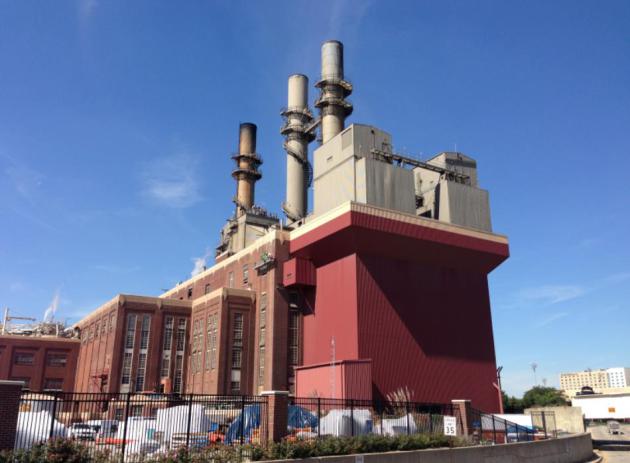
Why Congress Just Killed a Rule Restricting Coal Companies From Dumping Waste in Streams. Vox reports: "...On Thursday, the Senate voted 54-45 to repeal the so-called “stream protection rule” — using a regulation-killing tool known as the Congressional Review Act.
The House took a similar vote yesterday, and if President Trump agrees,
the stream protection rule will be dead. Coal companies will now have a
freer hand in dumping mining debris in streams. Killing this regulation
won’t really help Trump fulfill his goal of reversing the coal
industry’s decline; that decline has more to do with cheap natural gas
than anything else. Instead, Republicans are mostly focusing on this
rule because they can. Because the stream protection rule wasn’t
finished until very late in 2016, it’s much, much easier to kill than
most of the other Obama-era rules around coal pollution. It was an easy
target, so long as the GOP acted fast..."
Energy is the New Internet. I happen to agree with Brian LaKamp at totempower.net: "...At
heart, the Enernet is the foundation for smart-city tech, including the
“Internet of Things,” distributed systems, interconnected backbones and
networking technologies, EV-charging services and autonomous vehicles,
to name a few. These technologies will drive dramatic change and force
us to rethink our cities, municipal services and sectors like
transportation, insurance, real estate and financial services. From the
Enernet evolution will come smart cities that are an order-of-magnitude
smarter, healthier and safer. The new network will also present quantum
leaps in energy security and emergency resilience that can stand in the
face of superstorms or cyberattacks. Hold on to your seats. We’re at the
early stages of something immense..."

Lawmakers Could Find Common Ground on Energy Infrastructure Upgrade. Can Republicans and Democrats find common ground? Here's an excerpt from NexusMedia: "It’s pretty hard to identify any areas of cooperation between Democrats and Republicans right now, but one thing they both agree needs addressing is our nation’s infrastructure. It’s no secret that our many of nation’s roads, highways and power lines are out of date and in many places outright dangerous. America’s infrastructure earned a D+ on the American Society of Civil Engineers’ 2013 “Infrastructure Report Card.” The country’s dilapidated infrastructure costs households around $3,400 annually. Crumbling roads slow commutes and aging electricity grids make power bills more expensive. Notably, the nation’s energy system earned a lower grade than its bridges, ports and railways. Modernizing the electricity grid would improve resilience in the face extreme weather and cyber attacks, expand access to clean wind and solar energy, and shrink monthly power pills..." (Image credit: Pexel).
States Expected to Continue Course Toward Clean Energy Future. Here's an excerpt of a post at the PEW Charitable Trusts: "...The states have always led the country toward greater reliance on renewable energy sources, and they will continue to do so even if they don’t have the support of the incoming administration, said Gabe Pacyniak, a program manager at the Georgetown Climate Center, which helps states implement clean energy policies. Economic factors, such as the rapidly declining cost of wind and solar production, will help continue that trajectory, Pacyniak said. In the last two months alone, the Republican governors of Illinois, Maryland, Michigan, Ohio and Vermont have announced initiatives or signed bills that will push their states to increase their use of renewable energy. These are well-respected, “card-carrying conservatives who understand the benefits of the clean energy agenda,” said former Democratic Gov. Bill Ritter of Colorado, who is now director of the Center for the New Energy Economy at Colorado State University..."
Photo credit: "A worker installs solar panels on a roof in Honolulu. More states will encourage the use of renewable energy this year, seeing the economic benefits the industry brings." © The Associated Press.

Profits? Nice, But For These Investors Conscience Matters More. The New York Times reports: "...Passion
investors spurn such accommodations. They are driven by a belief in the
primacy of a cause — animal rights, climate change, reducing waste —
and try to apply that desire to all investment types. It’s not easy. “I
have a conversation about this quite often,” said Mark Doman, chief
executive of the Doman Group, an investment adviser.
“Clients talk about how their ethics and morality guide their
portfolio. I tell them it’s a very slippery slope to find companies that
meet their ethical bar while keeping in mind their goal is to grow
their assets.” Mr. Doman added, “If you can find me a morally and
ethically pure blue-chip company, that’s more the exception than the
rule...”
Photo credit: Kevin Kunishi.

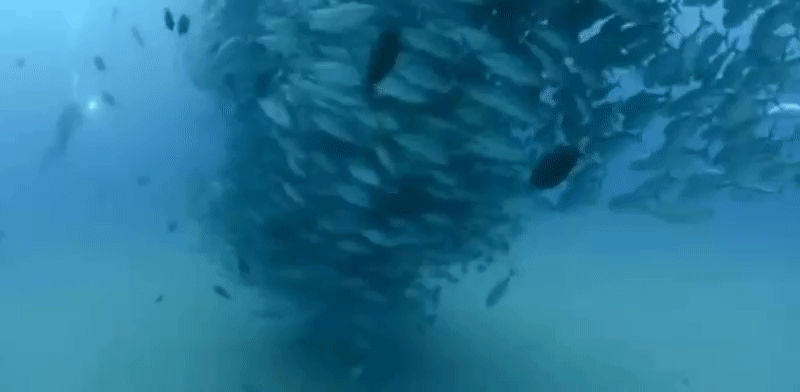
What On Earth is a "Tornado of Tuna"? You learn something every day - this nugget courtesy of Atlas Obscura: "A couple of times a year in the waters of Mexico’s Sea of Cortez, a colossal column of tuna churns slowly in an underwater fish vortex. The tunnel of over 100,000 Jack Tuna, or bigeye trevally, is large enough to cast looming shadows across the ocean floor. The clip above gives us a rare glimpse of what it’s like to be under this huge “tuna tornado.” At the 19-second mark, the camera is swallowed by the swirling silver mass. Each tuna averages over three feet in length. This fantastic phenomenon is the result of the tuna’s mating behavior..."

TODAY: Cloudy, flurries north - windy and milder. Winds: S 15-25. High: 34
SATURDAY NIGHT: Chance of light snow or flurries, mainly north of MSP. Coating possible. Low: 19
SUPER BOWL SUNDAY: More clouds than sun, cooler. Winds: NW 8-13. High: 29
MONDAY: Gray and dry, relatively mild for February. Winds: E 5-10. Wake-up: 18. High: 38
TUESDAY: Potential for a few slushy inches, potentially plowable. Winds: NE 10-15. Wake-up: 29. High: 33
WEDNESDAY: Gray with a cold wind and falling temperatures. Feels like -5. Winds: NW 10-20. Wake-up: 7. High: 11
THURSDAY: Partly sunny and brisk. Winds: NW 5-10. Wake-up: -2. High: 17
FRIDAY: Serious weather-whiplash. Windy with a taste of March. Winds: S 15-25. Wake-up: 15. High: 42
Climate Stories...
Pentagon: Arctic Melt Requires Updated U.S. Strategy. Climate Home reports on the jaw-dropping changes in the arctic, and how the military is trying to respond: "...An updated US military strategy for the Arctic says “diminishing ice levels” due to warming temperatures pose a series of security risks to the country. Released this week at the request of Alaska senator Dan Sullivan, a Republican, the 16-page document says the US must boost investment in its military assets around the North Pole. “Diminishing sea ice will give rise to new economic opportunities in the region while simultaneously increasing concerns about human safety and protection of a unique ecosystem that many indigenous communities rely on for subsistence,” reads the Arctic Strategy. “The breaking up of sea ice also threatens existing detection and warning infrastructure by increasing the rate of coastal erosion...”
Photo credit: "US National Guard troops in Utiqiagvik, Alaska." (Pic: Staff Sgt. Balinda O’Neal Dresel/US Army National Guard).
Photo credit: "This Nov. 10, 2016, aerial photo released by NASA, shows a rift in the Antarctic Peninsula's Larsen C ice shelf." (Photo: John Sonntag, AP)
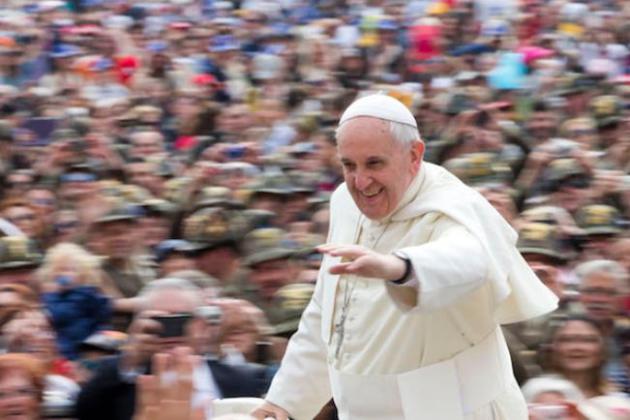
The Lasting Effects of Pope Francis' Climate Change Edict. Here's a clip from Pacific Standard: "...But newly published research
suggests the pontiff’s call for taking care of the Earth has had a more
subtle impact on American public opinion. It finds brief exposure to a
photograph of the pope “increased perceptions of climate change as a
moral issue.” What’s more, this shift in how the issue is
perceived was particularly strong among Republicans — a group that has
traditionally been resistant to acknowledging the fact that humans are
affecting the Earth’s climate in dangerous ways..." (File photo: AP).
Image credit: "There have been extensive revisions made to the EPA's climate collaboration page, including removing language about carbon pollution." Credit: EDGI.
The March For Science Isn't Partisan or Anti-Trump - It's Pro-Facts. Quartz reports: "...First came the Women’s March. Now comes the March for Science. Given the ongoing protests sweeping the US, one might assume that scientists are organizing to voice their general disagreement with Donald Trump’s policies—or perhaps that they simply want to protect their grants and jobs from federal funding cuts. But what’s at stake is much bigger than funding. It’s true that the US spends more on science than any other country. This long-term commitment has led to the US being awarded more Nobel Prizes than any other nation, with the majority of the 365 prizes being awarded for physics. The US also publishes more scientific papers than any other nation—twice as many as China, which ranks second. But scientists in the US and around the world are not mobilizing to defend themselves. Rather, they are fighting to protect the fundamental role that science plays in society and government..."
Image credit: "When the government starts trying to stifle science, you know the stakes are high."(NASA/Public Domain)

Republicans Try a New Tack on Climate Change. Here's a snippet from The New York Times: "...But
the most interesting statements came from Rick Perry, Mr. Trump’s
nominee to head the Department of Energy. Under questioning, Mr. Perry,
the former Texas governor, was surprisingly positive about the role the
federal government might play in developing advanced clean-energy
technology. Many people — Bill Gates among them — see this as the most
urgent issue. Renewable energy and greater use of natural gas are
helping lower emissions in the short run, but if we do not invest
heavily in research and development now, we may not have the technology we will eventually need
to get to zero emissions. People like Mr. Gates and the entrepreneur
Elon Musk are working on Mr. Trump. If the president’s mind is really
open on global warming, as he said after the election, perhaps he could also sit down with a few of our brightest climate scientists..."
"Listen to Evidence": March for Science Plans Washington Rally on Earth Day. Here's an excerpt from The New York Times: "Within a week of its creation, the March for Science
campaign had attracted more than 1.3 million supporters across Facebook
and Twitter, cementing itself as a voice for people who are concerned
about the future of science under President Trump. Now, hoping to
transform that viral success into something approaching the significance
of the women’s march last month, the campaign has scheduled its demonstration in Washington for Earth Day,
April 22. “Yes, this is a protest, but it’s not a political protest,”
said Jonathan Berman, a postdoctoral fellow at the University of Texas
Health Science Center at San Antonio and a lead organizer of the march.
“The people making decisions are in Washington, and they are the people
we are trying to reach with the message: You should listen to evidence...”
Photo credit: "A
women’s march in Fairbanks, Alaska, last month. The movement inspired a
group of scientists to organize their own demonstration in Washington." Credit Robin Wood/Fairbanks Daily News-Miner, via Associated Press.
Global Warming Threatens Winter Sports. Climate Central reports: "...The number of days below 32°F in the U.S. has been declining. This trend is projected to continue, threatening many of the winter activities that rely on cold conditions, including skiing, snowmobiling, ice fishing, and outdoor ice hockey. These winter recreational activities are an integral part of the economy in many states. Data from 2009-10 show that the ski, snowboard, and snowmobiling industries were directly and indirectly responsible for employing 211,900 people and adding an estimated $12.2 billion in economic value to the U.S. economy. As winter loses its chill, these winter tourism activities will be impacted and with them, people’s livelihoods..."
Photo credit: "People hold signs as they listen to a group of scientists speak during a rally in conjunction with the American Geophysical Union’s fall meeting Tuesday, Dec. 13, 2016, in San Francisco. The rally was to call attention to what scientist believe is unwarranted attacks by the incoming Trump administration against scientists advocating for the issue of climate change and its impact." (AP Photo/Marcio Jose Sanchez).
No comments:
Post a Comment